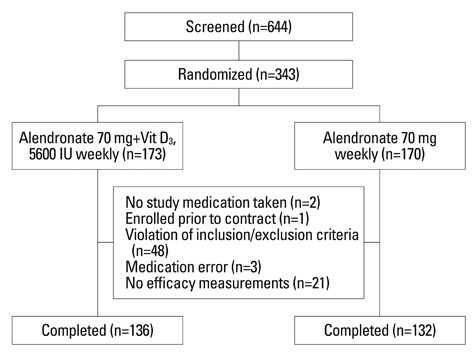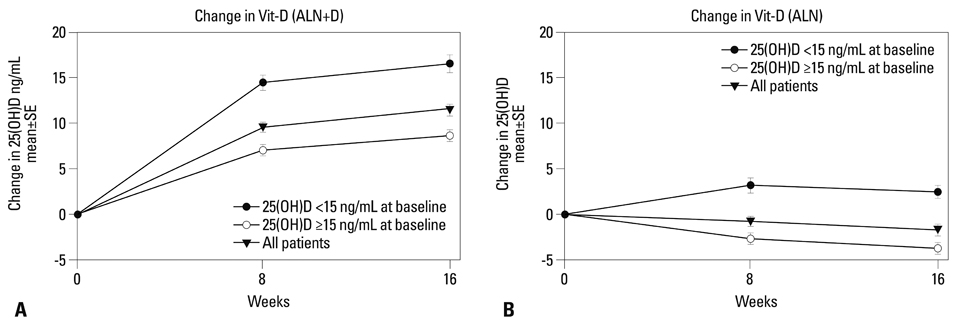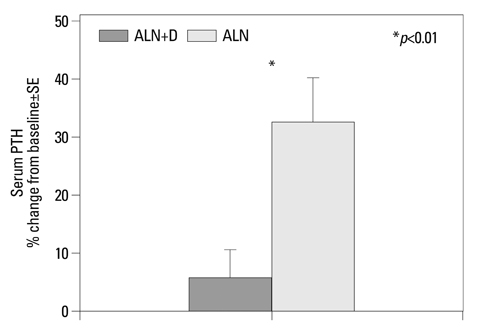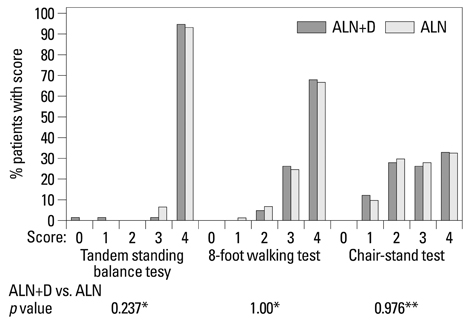Yonsei Med J.
2014 May;55(3):715-724. 10.3349/ymj.2014.55.3.715.
Efficacy and Safety of Weekly Alendronate Plus Vitamin D3 5600 IU versus Weekly Alendronate Alone in Korean Osteoporotic Women: 16-Week Randomized Trial
- Affiliations
-
- 1Division of Endocrinology, Department of Internal Medicine, Yonsei University College of Medicine, Seoul, Korea. lsk@yuhs.ac
- 2Severance Executive Healthcare Clinic, Severance Hospital, Yonsei University Health System, Seoul, Korea.
- 3Severance Check-up, Severance Hospital, Yonsei University Health System, Seoul, Korea.
- 4Division of Endocrinology and Metabolism, Department of Medicine, Samsung Medical Center, Sungkyunkwan University School of Medicine, Seoul, Korea.
- 5Division of Endocrinology and Metabolism, Asan Medical Center, University of Ulsan College of Medicine, Seoul, Korea.
- 6Department of Endocrinology and Metabolism, Ajou University School of Medicine, Suwon, Korea.
- 7Division of Endocrinology, Department of Internal Medicine, Seoul National University Bundang Hospital, Seoul National University College of Medicine, Seongnam, Korea.
- 8Division of Endocrinology and Metabolism, Department of Internal Medicine, Soonchunhyang University Seoul Hospital, Seoul, Korea.
- 9Division of Endocrinology and Metabolism, Department of Internal Medicine, Pusan National University School of Medicine, Busan, Korea.
- 10Division of Endocrinology, Department of Internal Medicine, Maryknoll Medical Center, Busan, Korea.
- 11Division of Rheumatology, Department of Internal Medicine, University of Ulsan College of Medicine, Gangneung Asan Hospital, Gangneung, Korea.
- 12Department of Endocrinology and Metabolism, Eulji University College of Medicine, Seoul, Korea.
- 13Division of Endocrinology, Department of Internal Medicine, Cheil General Hospital and Woman's Health Center, Kwandong University School of Medicine, Seoul, Korea.
- 14Department of Obstetrics and Gynecology, Chung-Ang University College of Medicine, Seoul, Korea.
- 15Department of Internal Medicine, Seoul National University College of Medicine, Seoul, Korea.
- 16Department of Internal Medicine, Seoul National University Bundang Hospital, Seoul National University College of Medicine, Seongnam, Korea.
- 17Division of Endocrinology and Metabolism, Department of Internal Medicine, Chonnam National University Medical School, Gwangju, Korea.
- 18Division of Endocrinology and Metabolism, Department of Internal Medicine, Soonchunhyang University Bucheon Hospital, Bucheon, Korea.
- 19Division of Endocrinology and Metabolism, Department of Internal Medicine, Chonbuk National University Medical School, Jeonju, Korea.
- 20Department of Orthopaedic Surgery, Yonsei University College of Medicine, Seoul, Korea.
- 21MSD Korea Ltd., Global Medical Affairs, Seoul, Korea.
- KMID: 2068682
- DOI: http://doi.org/10.3349/ymj.2014.55.3.715
Abstract
- Vitamin D (vit-D) is essential for bone health, although many osteoporosis patients have low levels of 25-hydroxy-vit-D [25(OH)D]. This randomized, open-label study compared the effects of once weekly alendronate 70 mg containing 5600 IU vit-D3 (ALN/D5600) to alendronate 70 mg without additional vit-D (ALN) on the percent of patients with vit-D insufficiency [25(OH)D <15 ng/mL, primary endpoint] and serum parathyroid hormone (PTH, secondary endpoint) levels in postmenopausal, osteoporotic Korean women. Neuromuscular function was also measured. A total of 268 subjects were randomized. Overall, 35% of patients had vit-D insufficiency at baseline. After 16-weeks, there were fewer patients with vit-D insufficiency in the ALN/D5600 group (1.47%) than in the ALN group (41.67%) (p<0.001). Patients receiving ALN/D5600 compared with ALN were at a significantly decreased risk of vit-D insufficiency [odds ratio=0.02, 95% confidence interval (CI) 0.00-0.08]. In the ALN/D5600 group, significant increases in serum 25(OH)D were observed at weeks 8 (9.60 ng/mL) and 16 (11.41 ng/mL), where as a significant decrease was recorded in the ALN group at week 16 (-1.61 ng/mL). By multiple regression analysis, major determinants of increases in serum 25(OH)D were ALN/D5600 administration, seasonal variation, and baseline 25(OH)D. The least squares mean percent change from baseline in serum PTH in the ALN/D5600 group (8.17%) was lower than that in the ALN group (29.98%) (p=0.0091). There was no significant difference between treatment groups in neuromuscular function. Overall safety was similar between groups. In conclusion, the administration of 5600 IU vit-D in the ALN/D5600 group improved vit-D status and reduced the magnitude of PTH increase without significant side-effects after 16 weeks in Korean osteoporotic patients.
MeSH Terms
Figure
Cited by 1 articles
-
Pharmacologic treatment of osteoporosis
Yong-Ki Min
J Korean Med Assoc. 2016;59(11):847-856. doi: 10.5124/jkma.2016.59.11.847.
Reference
-
1. Center JR, Nguyen TV, Schneider D, Sambrook PN, Eisman JA. Mortality after all major types of osteoporotic fracture in men and women: an observational study. Lancet. 1999; 353:878–882.
Article2. Johnell O, Kanis JA. An estimate of the worldwide prevalence and disability associated with osteoporotic fractures. Osteoporos Int. 2006; 17:1726–1733.
Article3. Shi N, Foley K, Lenhart G, Badamgarav E. Direct healthcare costs of hip, vertebral, and non-hip, non-vertebral fractures. Bone. 2009; 45:1084–1090.
Article4. Jang SN, Choi YH, Choi MG, Kang SH, Jeong JY, Choi YJ, et al. [Prevalence and associated factors of osteoporosis among postmenopausal women in Chuncheon: Hallym Aging Study (HAS)]. J Prev Med Public Health. 2006; 39:389–396.5. Jung JK, Kim HJ, Lee HK, Kim SS, Shin CS, Kim JT. Fracture incidence and risk of osteoporosis in female type 2 diabetic patients in Korea. Diabetes Metab J. 2012; 36:144–150.
Article6. Lee SH, Lee TJ, Cho KJ, Shin SH, Moon KH. Subsequent hip fracture in osteoporotic hip fracture patients. Yonsei Med J. 2012; 53:1005–1009.
Article7. Shin CS, Choi HJ, Kim MJ, Kim JT, Yu SH, Koo BK, et al. Prevalence and risk factors of osteoporosis in Korea: a community-based cohort study with lumbar spine and hip bone mineral density. Bone. 2010; 47:378–387.
Article8. Holick MF, Chen TC. Vitamin D deficiency: a worldwide problem with health consequences. Am J Clin Nutr. 2008; 87:1080S–1086S.
Article9. Adami S, Giannini S, Bianchi G, Sinigaglia L, Di Munno O, Fiore CE, et al. Vitamin D status and response to treatment in post-menopausal osteoporosis. Osteoporos Int. 2009; 20:239–244.
Article10. Koo JH, Kim HK, Kim IS, Kim EK, Chung YS. The effects of combined treatment of alendronate plus active or plain vitamin D on the vitamin D metabolism and bone turnover markers in patients with osteoporosis. Endocrinol Metab. 2010; 25:305–309.
Article11. Bischoff-Ferrari HA, Willett WC, Wong JB, Giovannucci E, Dietrich T, Dawson-Hughes B. Fracture prevention with vitamin D supplementation: a meta-analysis of randomized controlled trials. JAMA. 2005; 293:2257–2264.12. Pfeifer M, Begerow B, Minne HW. Vitamin D and muscle function. Osteoporos Int. 2002; 13:187–194.
Article13. Holick MF. Vitamin D deficiency. N Engl J Med. 2007; 357:266–281.
Article14. Holick MF. Sunlight and vitamin D for bone health and prevention of autoimmune diseases, cancers, and cardiovascular disease. Am J Clin Nutr. 2004; 80:6 Suppl. 1678S–1688S.
Article15. Lim SK, Kung AW, Sompongse S, Soontrapa S, Tsai KS. Vitamin D inadequacy in postmenopausal women in Eastern Asia. Curr Med Res Opin. 2008; 24:99–106.
Article16. Rizzoli R, Eisman JA, Norquist J, Ljunggren O, Krishnarajah G, Lim SK, et al. Risk factors for vitamin D inadequacy among women with osteoporosis: an international epidemiological study. Int J Clin Pract. 2006; 60:1013–1019.
Article17. Recker R, Lips P, Felsenberg D, Lippuner K, Benhamou L, Hawkins F, et al. Alendronate with and without cholecalciferol for osteoporosis: results of a 15-week randomized controlled trial. Curr Med Res Opin. 2006; 22:1745–1755.
Article18. National Osteoporosis Foundation, American Academy of Orthopaedic Surgeons. Physician's guide to prevention and treatment of osteoporosis. 2nd ed. Washington, D.C.: National Osteoporosis Foundation;2003.19. Institute of Medicine (U.S.). Standing Committee on the Scientific Evaluation of Dietary Reference Intakes, Institute of Medicine (U.S.). Subcommittee on Upper Reference Levels of Nutrients, Institute of Medicine (U.S.). Subcommittee on Interpretation, Uses of Dietary Reference Intakes. Dietary reference intakes. a report of the Subcommittee on Interpretation and Uses of Dietary Reference Intakes and the Standing Committee on the Scientific Evaluation of Dietary Reference Intakes, Food and Nutrition Board, Institute of Medicine. Applications in dietary assessment. Washington, D.C.: National Academy Press;2001.20. Guralnik JM, Ferrucci L, Simonsick EM, Salive ME, Wallace RB. Lower-extremity function in persons over the age of 70 years as a predictor of subsequent disability. N Engl J Med. 1995; 332:556–561.
Article21. Guralnik JM, Simonsick EM, Ferrucci L, Glynn RJ, Berkman LF, Blazer DG, et al. A short physical performance battery assessing lower extremity function: association with self-reported disability and prediction of mortality and nursing home admission. J Gerontol. 1994; 49:M85–M94.
Article22. DeLuca HF. Overview of general physiologic features and functions of vitamin D. Am J Clin Nutr. 2004; 80:6 Suppl. 1689S–1696S.
Article23. Holick MF. High prevalence of vitamin D inadequacy and implications for health. Mayo Clin Proc. 2006; 81:353–373.
Article24. van Etten E, Decallonne B, Mathieu C. 1,25-dihydroxycholecalciferol: endocrinology meets the immune system. Proc Nutr Soc. 2002; 61:375–380.
Article25. Lips P, Wiersinga A, van Ginkel FC, Jongen MJ, Netelenbos JC, Hackeng WH, et al. The effect of vitamin D supplementation on vitamin D status and parathyroid function in elderly subjects. J Clin Endocrinol Metab. 1988; 67:644–650.
Article26. Drake MT, Clarke BL, Khosla S. Bisphosphonates: mechanism of action and role in clinical practice. Mayo Clin Proc. 2008; 83:1032–1045.
Article27. Vasikaran SD. Bisphosphonates: an overview with special reference to alendronate. Ann Clin Biochem. 2001; 38(Pt 6):608–623.
Article28. Horwitz MJ, Tedesco MB, Sereika SM, Syed MA, Garcia-Ocaña A, Bisello A, et al. Continuous PTH and PTHrP infusion causes suppression of bone formation and discordant effects on 1,25(OH)2 vitamin D. J Bone Miner Res. 2005; 20:1792–1803.
Article29. Wang YH, Liu Y, Buhl K, Rowe DW. Comparison of the action of transient and continuous PTH on primary osteoblast cultures expressing differentiation stage-specific GFP. J Bone Miner Res. 2005; 20:5–14.
Article
- Full Text Links
- Actions
-
Cited
- CITED
-
- Close
- Share
- Similar articles
-
- Erratum to "Efficacy and Safety of Weekly Alendronate Plus Vitamin D3 5600 IU versus Weekly Alendronate Alone in Korean Osteoporotic Women: 16-Week Randomized Trial" by Kim KJ, et al. (Yonsei Med J 2014;55:715-24.)
- Efficacy and Safety of Monthly 150 mg Oral Ibandronate in Women with Postmenopausal Osteoporosis: A Systematic Review and Meta-analysis of Randomized Controlled Trials
- Comparison of Bone Mineral Density and Markers of Bone Turnover in Osteoporotic Women after 6-Month Treatment with Alendronate or Bazedoxifene: A Randomized Controlled Trial
- Comparison of the efficacy of three once-weekly bisphosphonates on bone mineral density gains in Korean women
- Letter: The Effects of Combined Treatment of Alendronate Plus Active or Plain Vitamin D on the Vitamin D Metabolism and Bone Turnover Marker in Patients with Osteoporosis (Endocrinol Metab 25:305-309, 2010, Jee-Hoon Koo et al.)





